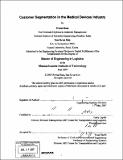| dc.contributor.advisor | Larry Lapide. | en_US |
| dc.contributor.author | Basu, Probal | en_US |
| dc.contributor.author | Kim, Eun Kyun | en_US |
| dc.contributor.other | Massachusetts Institute of Technology. Engineering Systems Division. | en_US |
| dc.date.accessioned | 2008-02-04T20:47:16Z | |
| dc.date.available | 2008-02-04T20:47:16Z | |
| dc.date.copyright | 2007 | en_US |
| dc.date.issued | 2007 | en_US |
| dc.identifier.uri | http://hdl.handle.net/1721.1/40110 | |
| dc.description | Thesis (M. Eng. in Logistics)--Massachusetts Institute of Technology, Engineering Systems Division, 2007. | en_US |
| dc.description | Includes bibliographical references (p. 73-76). | en_US |
| dc.description.abstract | This thesis addresses Company X's concerns about its product shipment options. The company ships over 70% of its products to its customers using the primary service provider that ensures that the product is at the customer site by 10:30 AM next day. As per the understanding with its customers, the company, absorbs the cost of premium shipping and does not pass it on to most of its customers. The company believes that this priority service is a source of competitive advantage that helps it get customer loyalty and thereby increases sales. However it is not a normal industry practice to provide this service free to the customers. Keeping in mind this enormous cost burden, Company X wants to minimize this cost. Medical device sales are non-seasonal and do not show promotional effects. We analyzed data for the months of June and October, 2006 as a part of our research. The objective of our data analysis was to validate the proposed approaches we reviewed as a basis for proposing ways to segment customers for improving service while reducing cost. We proposed three types of segmentation: by region, by order method and by division. Segmentation by region looks at dividing the customers by into 4 regions based on their location. | en_US |
| dc.description.abstract | (cont.) Segmentation by ordering method splits the customers in terms of whether they order using phone, fax or EDI while segmentation by division breaks up the customer base in terms of the various divisions the company has. Our study revealed that the company can expect to save over 3 million dollars annually by not offering this service free of charge to its customers. If customers are not convinced that the lower level of service meets their needs, they may pay for use of premium shipping. We demonstrate that the lower level of service will likely be just as effective and hence the company can guarantee that the product would reach the customer on time. Given the criticality of the parts that the company ships, it is advised to take its customers into confidence before making major policy changes. | en_US |
| dc.description.statementofresponsibility | by Probal Basu [and] Eun Kyun Kim. | en_US |
| dc.format.extent | 76 p. | en_US |
| dc.language.iso | eng | en_US |
| dc.publisher | Massachusetts Institute of Technology | en_US |
| dc.rights | M.I.T. theses are protected by copyright. They may be viewed from this source for any purpose, but reproduction or distribution in any format is prohibited without written permission. See provided URL for inquiries about permission. | en_US |
| dc.rights.uri | http://dspace.mit.edu/handle/1721.1/7582 | |
| dc.subject | Engineering Systems Division. | en_US |
| dc.title | Customer segmentation in the medical devices industry | en_US |
| dc.type | Thesis | en_US |
| dc.description.degree | M.Eng.in Logistics | en_US |
| dc.contributor.department | Massachusetts Institute of Technology. Engineering Systems Division | |
| dc.identifier.oclc | 184986891 | en_US |
